SUGARCANE DISEASES- SYMPTOMS & CONTROL
The present day commercial sugarcane varieties are man-made hybrid clones involving Saccharum officinarum L., and S.spontaneum with a few genes incorporated from, S. barberi Jesw., S. sinense Roxb. and to a limited extent S. robustum Brandes.
North Indian canes differ from S. officinarum by
- Floral characteristics
- Thin to medium stalks
- Low to moderate sucrose content
- Higher fibre
- Greater tolerance to adverse conditions
FUNGAL DISEASE
Redrot (Causal organism– Colletotrichum falcatum Went)
Symptoms
- Disease-infected setts are planted; they result in failure of germination or death of germinated settling.
- In seedling stage the infected plants show yellowing in leaf and subsequently plants dry singly or in clump.
- In highly susceptible varieties mid rib lesions are observed after summer rains. In the later stage the red rot infected canes show dull red to brown shades on the nodal regions and during severe infection pinkish sporulation can be seen on rind and leaf scars.
- When the infected canes are split open, the internal cane tissue shows red discoloration with whitish patches.
- Spread mode– The pathogen primarily spread through infected setts and crop debris surviving in the soil. The secondary infection occurs through flood water, rain splashes and irrigation water.
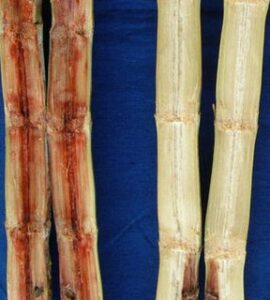
Management
Cultural method
- Select healthy plants in a disease- free area.
- The red rot affected field must be rotated with rice for one season and other crops for two seasons.
- Growing of recommended resistant varieties viz., Co 86032.
Physical method
- Remove affected clumps at an early stage and soil drenching with Carbendazim 50 WP (1 gm in 1 litre of water).
- The cut ends and entire setts should be dipped in a fungicide solution, such as one per cent Bordeaux mixture.
- Affected leaves and canes should be collected and destroyed by burning.
Chemical method
- Sett treatment with Carbendazim 50 WP (0.5 gm in 1 litre of water) before planting along with 2.5 kg of Urea in 250 litre of water
- Use fungitoxic chemicals like Bavistin, Benomyl, Topsin at 0.1% for 18 min. at 52ºC for dipping setts which gave almost complete elimination of rot infection.
Smut (Causal organism– Sporisorium scitamineum (Syd.) M. Piepenbr., M. Stoll & Oberw Syn: (Ustilago scitaminea)
Symptoms
- Whip like structure on infected plants comprising of central host tissue surrounded by a thin layer of black teliospores covered by a thin silvery white membrane.
- Later, the white membrane disintegrates and the spores are readily dispersed by wind and rain.
- Bushy and grassy appearance of clumps with an abnormally high number of small stalks and whips in shoots.
- Primary Spread through infected setts and secondary infection occurs through wind-blown teliospores disperse from the whip.
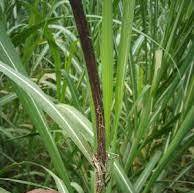
Management
Cultural method
- Grow resistant varieties.
- Discourage ratooning of the diseased crops having more than 10% infection.
- Arhar can be grown as a companion crop between rows of sugarcane, and the secondary spread of the disease is substantially reduced.
Physical method
- Treating the seed setts in hot water at 50 ºC for 30 minutes or at 52 ºC for 18 minutes.
- Rouging of smut whips with gunny bags/polythene bag and dipped in boiling water for 1 hour, and diseased clumps must be uprooted and burnt
Chemical method
- Sett treatment with fungicides with Carbendazim @ 1gm in 1 litre of water for 10 minutes.
- Spray on infected stools with a small amount of a 10% solution of roundup, using a small hand held sprayer.
- In severe cases spray the entire block with glyphosate (360 G/L) at 5-7 lit/ha.
Wilt (causal organism- Fusarium sacchari)
Symptoms
- Symptom appears on 4-5 months old plant as gradual yellowing and drying of leaves and cane.
- Plants become completely dry and die leaving hollow stalks.
- In the infected cane inter-nodal tissues shrink and boat shaped cavities are formed due to loss of moisture.
- Internally internode tissue turns to dark-purplish or pinkish or reddish brown in colour.
- Primary spread is through infected setts, soil borne pathogen inoculum and also infected debris. The secondary spread occurs through wind, rain and irrigation water.
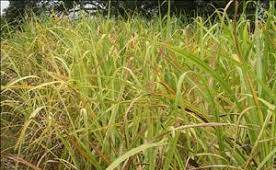
Management
Cultural method
- Selection of healthy seed setts from disease-free area for planting.
- Grow resistant varieties like Co 617 and B.P.17.
- Crop rotation, managing root borer, avoiding prolonged drought and water logging and hygienic practices.
Chemical Method
- Dipping the setts in 40 ppm of boron or manganese, or spraying the plants with either of these minor elements to reduces the disease intensity.
- Sett treatment with fungicide like Bavistin, 0.1% before planting.
- Apply carbendazim @ 2gm/lit of water at the root zone area and same as follow at 15 days interval.
Pineapple disease (Ceratocystis paradoxa)
Symptoms
- The infected sugarcane setts rot and result in poor germination and drying of young sugarcane shoots at emergence leaving lot of gaps in the field.
- When split open internodal tissues of infected setts appear reddish and pineapple smell noticed due to production of ethyl acetate.
- Later stages of infection show blackish internodal tissues due to the production of chlamydospores distributed between vascular bundles.
- Water stagnation after planting or deep planting favour incidence and severity of the disease.
- Spread through soil borne conidia and chlamydospores and through irrigation water.
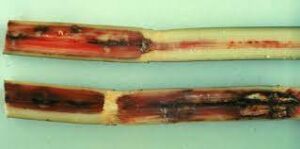
Rust
Causal organism- Common rust- Puccinia melanocephala; Orange rust- Puccinia kuehnii
Symptom
- Small, elongated, yellowish spots on both the sides of the leaf surface. The spots increase in size and turn to reddish to brown/ orange brown to yellow brown and become pustular on the lower surface of the leaves.
- In case of severe incidence, numerous lesions occur on individual leaves, giving them drying appearance.
- Transmission is by wind and rain water splash.
Management
Cultural method
- The best way is to grow resistant varieties Dhanush, Kalyani etc.
- Affected leaves should be remove and burn immediately.
- Sugarcane grown in fields receiving recent applications of mill mud is typically very prone to rust.
Chemical method
- Spray Tridemorph 1.0 litres or Mancozeb 2.0 kg/ha.
- Use dithane M 45 @ 2 g/lit for one spraying.
- Application of triazole or strobilurin or pyraclostrobin fungicide @ 3 g/ lit of water.
Pokkah boeng/Top rots (Causal organism- Fusarium sacchari/ F. proliferatum spp.)
Symptom
- In the pokkah boeng phase, the disease exhibits characteristic twisted top in affected canes with different types of leaf malformation.
- In the top rot phase, the disease is characterized by rotting of spindle leaf.
- Most of the pokkah boeng infected canes generally recover from the symptoms, but top rot phase never recover from the damage.
- In the acute phase wilting of plant is noticed, which is characterized by yellowing and drying of leaves and stalks.
- Primary spread is through infected seed cane and left over infected debris. The secondary spread is through wind, rain and irrigation water.
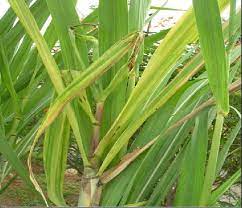
BACTERIAL DISEASE
Ratoon stunting disease (RSD)
Causal organism- Leifsonia (Clavibacter) Xyli subsp. Xyli
Symptoms
- The infected canes become thin and produce shorter stalks and reduction in number of stalks.
- The disease is intensified by abiotic stress like water logging and drought.
- The internal vascular bundles become yellow to reddish with brown dots, commas or short lines at nodal region.
- Infected cuttings and mechanical transmission through cutting implements/knives.
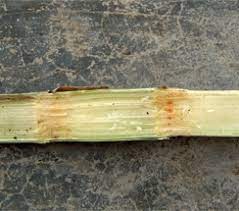
Management
Cultural method
- Select healthy setts for planting.
- Proper sanitation of field.
- Ingeminated setts should be removed and fill the gap with new setts which should be treated before planting.
Mechanical method
- Treat the setts with hot water at 50°C for about 2 hours.
- Aerated steam therapy eliminates the pathogen from the infected canes.
- Use of disinfectants to clean seed cutting tools would reduce the chance of spread of pathogen from the infected to healthy setts.
Chemical method
- A chemical disinfectant may be used on cane cutting knives includes, Lysol, Dettol, ethanol etc. Atleast 5 minutes of contact with the cutting surface is needed to assure disinfection.
Leaf scald (LSD)
Causal organism- Xanthomonas albilineans
- Very often the disease may remain under latent phase without exhibiting any symptoms.
- The disease symptoms include chlorotic (white) stripes on leaves (Leaf Scald 1), axillary bud sprouting (Leaf Scald 2) and burnt appearance of the leaf tips.
- Internally the stalk tissues show vascular discolouration both in the nodes and internodes (Leaf Scald 3).
- Under Indian conditions we do not get typical white (pencil-line) stripes on leaves along the veins; instead we see typical bacterial blights.
- Infected cuttings and mechanical transmission through cutting implements/knives.
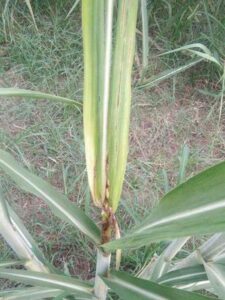
Red stripe
Causal organism– Acidovorax avenae subsp. avenae (Xanthomonas rubrilineans)
- It is most common in the subtropical region and appears from May and lasts up to November.
- Affected leaves show parallel red streaks, more prominently on the proximal region of the lamina (Red stripe 1).
- Severe infections lead to top rot phase of the disease (Red stripe 2) in which the meristem is killed and exhibiting dried spindle and bud sprouting in basipetal manner.
- Infected cuttings, mechanical transmission through cutting implements/knives and aerial spread.
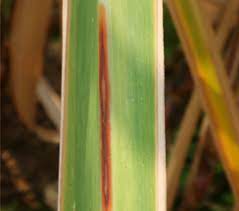
Grassy Shoot Disease (GSD)
Causal organism- Sugarcane grassy shoot (SCGS) phytoplasma
Symptom
- Production of numerous, thin, slender chlorotic tillers (grassy shoots) and chlorosis of leaves.
- The infection causes reduction in leaf size, number, length and breadth of leaf lamina and premature proliferation of axillary buds.
- The GSD infected clump appears as bushy grass-like growth in vegetative parts of the host plant resulting in the formation of no millable canes or only a few dwarfed canes are produced.
- The pathogen spreads through infected setts and insect vectors.
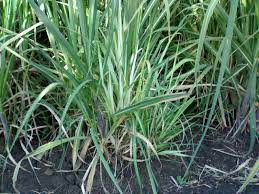
Management
Cultural method
- Grow resistant varieties.
- Avoid ratooning if Grassy Shoot Disease incidence is more than 15 % in the plant crop.
- If disease symptoms are visible within two weeks after planting, such plants can be replaced by healthy plants.
- Uprooted infected plants need to disposed of by burning them.
Physical method
- Rogue out infected plants in the secondary and commercial seed nursery.
- Treat the setts with aerated steam at 50°C for 1 hour to control primary infection.
- Treating them with hot air at 54°C for 8 hours and spraying twice a month with aphidicides.
Chemical method
- Spray dimethoate @ 1ml in 1 litre of water to control insect vector.
- Apply pesticide methyl-demeton @ 2ml/lit of water for controlling aphids.
VIRAL DISEASE
Yellow leaf disease: Sugarcane yellow leaf virus (SCYLV) / Sugarcane yellow leaf phytoplasma (SCYP)
- Yellowing in the mid rib region in the lower surface during 6-8 months stage.
- During the disease progress, lateral spread of yellow discoloration occurs and necrosis of leaf occurs from leaf tip towards the base and this result in drying of foliage.
- Severe virus infection also leads to shortening of terminal internodes and this result in bunching of top leaves in the infected canes.
- The disease is responsible for varietal degeneration in sugarcane.
- Primary spread by infected cuttings and secondary spread by aphid vectors , Melanaphis sacchari.
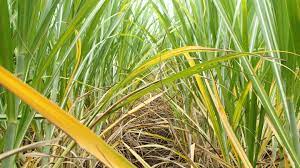
Management
Cultural method
- Select disease free setts for planting.
- Field sanitation.
- Proper nutritional management and use of resistant varieties.
- To avoid this disease first plant the setts in nursery and then transplant to main field.
- Selection of tissue culture plant especially meristem culture plant is used for planting in field.
Chemical method
- Secondary transmission of the disease by insect vectors can be controlled by application of Malathion(0.1%) or Dimecron(0.2%).
- Soil application of carbofuran @2.0 kg./ha or phorate @ 6.0 kg./ha.
- Two sprayings of malathion @ 1.5 kg /ha at monthly intervals during September and October after detrashing of dry leaves.
Sugarcane mosaic
Symptom
- Contrasting dark green and light green shades on the leaf lamina due to the varying levels of chlorophyll concentration on leaf blade caused by the virus.
- Primary spread is through infected seed canes and secondary spread by aphids.
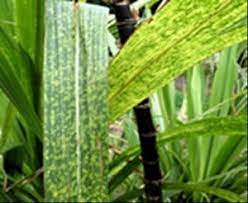
Leaf Fleck
Symptom
- Occurs throughout the country.
- Major symptoms include appearance of flecks or specks throughout leaf lamina (Leaf Fleck 1).
- Gradually, the chlorotic flecks increase in size, turn yellow and reddish. In extremely severe cases entire leaf turns yellow or reddish and symptoms appear close to yellow spot symptoms (Leaf Fleck 2).
- Severe disease expression leads to premature drying and death of the leaves (Leaf Fleck 3).
- Primary spread is through infected seed canes and secondary spread by mealy bug Sacccharicoccus sacchari.
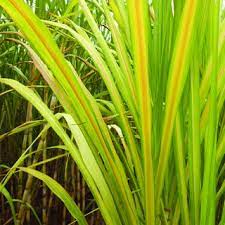
Other diseases of sugarcane
Disease Causal organism Gumming disease Xanthomonas campestris pv. vasculorum Red stripe Pseudomonas rubrilineans Eye spot Bipolaris sacchari Leaf scorch Stagnospora sacchari Ring spot Leptosphaeria sacchari Brown spot Cerspora longipes Brown stripe Cochliobolus stenophilus, Helminthosporium stenopilum Leaf spots Curvularia sp., Helminthosporium sp., Periconia sp. Yellow spot Mycovellociella koepkei. Stalk rot Phaeocytostroma sacchari
(Source- ICAR)